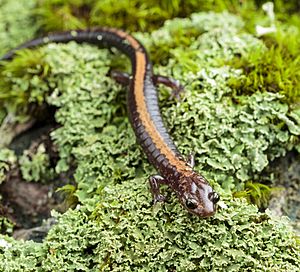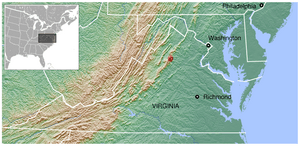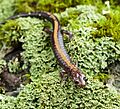Shenandoah salamander facts for kids
Quick facts for kids Shenandoah salamander |
|
|---|---|
 |
|
| Conservation status | |
| Scientific classification | |
| Genus: |
Plethodon
|
| Species: |
shenandoah
|
 |
|
| The habitat of the Shenandoah salamander is limited to 3 talus slopes within the Shenandoah National Park in Virginia | |
| Synonyms | |
|
Plethodon richmondi shenandoah Highton and Worthington, 1967 |
|
The Shenandoah salamander (Plethodon shenandoah) is a small salamander that lives only on land. You can find it only in Shenandoah National Park in Virginia, USA. This special salamander lives in a very small area on just three mountain peaks. Because its home is so small, and it faces challenges from other animals and climate change, its population is at risk. Protecting its home from human activities is very important to help this species survive and grow.
Contents
About the Shenandoah Salamander
The adult Shenandoah salamander is thin and medium-sized. It usually grows to be about 3.5 to 4.5 inches (7 to 10 cm) long. This salamander has two main color types:
- Striped: This type has a thin stripe down its back. The stripe can be red or yellow.
- Unstriped: This type is mostly dark all over. It might have a few shiny, brass-colored spots.
Both color types have white or yellow spots along their sides.
The Shenandoah salamander looks a lot like the red-backed salamander (Plethodon cinereus). But you can tell them apart!
- The stripe on a Shenandoah salamander covers about one-third of its back. The red-backed salamander's stripe is wider, covering about two-thirds.
- The Shenandoah salamander does not have the "salt and pepper" pattern under its belly that the red-backed salamander has.
- Its head is also a bit bigger and more rounded.
Shenandoah salamanders are part of a group called Plethondontidae. These are "lungless" salamanders. This means they breathe through their skin! To do this, their skin must stay moist. This is why they need to live in damp places like forests. They are mostly active at night, looking for food. During the day, they hide in dark, wet spots like under rocks or logs.
Life Cycle and Diet
Like many woodland salamanders, the Shenandoah salamander eats tiny creatures. These include mites, flies, small beetles, springtails, and other small animals that live in the soil.
Scientists have not directly seen what eats the Shenandoah salamander. But animals that live in the same area might hunt them. These could include ring-necked snakes, short-tailed shrews, brown thrashers, and towhees.
We don't know everything about the Shenandoah salamander's life. But adult salamanders can live a long time, sometimes up to 25 years!
- They usually breed in late spring or summer.
- Female salamanders start breeding when they are at least 4 years old.
- They lay about 13 eggs every two years.
- The eggs are laid in moist places and hatch in 1 to 3 months.
- The young salamanders develop completely inside the egg. They do not have a water-dwelling larval stage.
- The mother salamander stays with her eggs to guard them. She does not leave to find food during this time.
All salamanders, including the Shenandoah salamander, are important for nature. They help control insect populations by eating them. They also help keep the soil healthy by digging burrows. This helps air get into the soil. They also play a role in how dead plants and animals break down.
Where They Live
Habitat Range
Scientists believe the Shenandoah salamander first came from the Appalachian Mountains in eastern North America. We don't know how many there used to be. Today, these salamanders live only on the north-facing rocky slopes (called talus slopes) of three mountains in Shenandoah National Park, Virginia: Hawksbill, The Pinnacles, and Stony Man. You can see their home on the range map.
Each of these three rocky slopes has its own group of salamanders. They live about 3,000 feet (914 meters) above sea level. These rocky slopes are usually dry. So, the Shenandoah salamander looks for small, moist spots within this dry environment.
Why do they live in these dry, rocky areas? Because the red-backed salamander is very competitive! The red-backed salamander lives in the moist, deep soil of the forests, which would be a better home for the Shenandoah salamander. But the red-backed salamander keeps the Shenandoah salamander out of these ideal spots.
Population Size
Based on information from 2008 and 2009, there were an estimated 110,262 to 140,625 Shenandoah salamanders. However, to know if the population is growing or shrinking, scientists need to do more studies where they mark the animals.
Main Dangers
Competition from Red-backed Salamanders
The Shenandoah salamander is threatened by the aggressive red-backed salamander. The red-backed salamander forces the Shenandoah salamander to live in drier, less ideal rocky areas. This stops the Shenandoah salamander from moving into the moist forest areas.
Also, the rocky slopes where the Shenandoah salamander lives are slowly breaking down due to erosion. Over time, this will create more soil and make the area wetter. This could allow the red-backed salamander to move into these areas, which would put the Shenandoah salamander at even greater risk of disappearing.
Studies in labs and in nature show that the red-backed salamander is very territorial towards the Shenandoah salamander. Both species want large rocks or logs that offer cool and moist conditions. But the red-backed salamander's aggressive behavior pushes the Shenandoah salamander out of these moist soil environments. So, the Shenandoah salamander, which can handle drier conditions better, is stuck in the rocky slopes where the red-backed salamander cannot survive.
Invasive Species
New insect species that are not native to Shenandoah National Park also threaten the Shenandoah salamander. These include the gypsy moth (Lymantria dispar dispar) and the hemlock woolly adelgid (Adelges tsugae).
- Gypsy moth larvae eat tree leaves. This causes many trees to lose their leaves and even die. When trees are gone, the ground becomes drier. This can make it harder for the Shenandoah salamander to find food.
- Hemlock woolly adelgids kill hemlock trees. This also leads to fewer trees and drier rocky slopes. When hemlock trees die, their needles fall to the ground and make the soil more acidic.
Acid rain and air pollution also make the soil more acidic in Shenandoah National Park. While we don't have direct proof of how soil acidity affects the Shenandoah salamander, studies show that amphibians are very sensitive to it. This means acidic soil could:
- Reduce how many babies they have.
- Affect their food supply.
- Make it harder for eggs to hatch.
- Increase the death rate of young salamanders.
Chytrid Fungus
A fungus called Batrachochytrium salamandrivorans, or Salamander Chytrid fungus, causes a disease called chytridiomycosis. This disease is a big reason why amphibian populations around the world are shrinking.
In 2016, the U.S. Fish and Wildlife Service (USFWS) made a rule. It added all salamander species to a list of harmful amphibians. This rule stopped people from bringing any live or dead salamanders into the United States or moving them between states. This was done to prevent the fungus from spreading.
Even though this fungus has killed many salamanders, it was not known to be in the U.S. at that time. But if it ever arrived, it could be very bad for salamander species like the Shenandoah salamander.
Human Activities
Human activities can also put the Shenandoah salamander in danger.
- Air pollution and acid rain can harm the trees and change the soil chemistry. While direct effects on the Shenandoah salamander haven't been fully proven, amphibians are very sensitive to acid rain, especially in mountain areas. Acidic soil could affect their food, their ability to reproduce, and the survival of their eggs and young.
- Hiking trails and backcountry camping can disturb the salamander's home. Maintenance of trails and people walking on them can damage their habitat.
Climate Change
Climate change directly affects the Shenandoah salamander's home. As the climate changes, the cloud base elevation (how high clouds are) is likely to shift. This will make the suitable living area for the Shenandoah salamander even smaller. One study found that elevation is very important for where the Shenandoah salamander can live, not just competition. The lower parts of their habitat are sensitive to climate changes. So, climate change in high mountain areas will directly impact where these salamanders can survive.
Conservation Status
In 1989, the Shenandoah salamander was officially listed as "Endangered" under the Endangered Species Act (ESA). This means it was in great danger of disappearing.
The IUCN (International Union for Conservation of Nature) first listed the Shenandoah salamander as Endangered in 1994. In 2004, its status was changed to "Vulnerable" (VU). This means it is still at risk, but perhaps not as immediately as "Endangered." The reason for this change was that it is found in only three specific locations.
Critical Habitat
In 2015, the Center for Biological Diversity asked the U.S. Fish and Wildlife Service to name a specific area as "critical habitat" for the Shenandoah salamander. They asked for 16,891 acres within Shenandoah National Park to be protected. Since the salamander needs very specific conditions to live and is only found in high mountains in Virginia, it is increasingly threatened by climate change, invasive species, pollution, and human activities. Naming this area as critical habitat would help protect it and guide how the Park Service manages the land, which would be good for the salamander.
What's Being Done to Help
Original 1994 Recovery Plan
The 1994 recovery plan for the Shenandoah salamander was special. Because of the competition with the red-backed salamander, it was decided that trying to increase their numbers or move them to new places would not be a good idea. It would be too hard and costly.
Instead, the plan focused on reducing human impacts on both the Shenandoah and red-backed salamander populations. The main goals were:
- Find the exact boundaries of where they live and see if there are other groups of salamanders.
- Keep an eye on the known salamander populations over a long time.
- Figure out and reduce the effects of human activities like pollution on the salamander.
- Learn more about the salamander's life.
- Make sure park maintenance and activities do not harm the salamanders.
- Share information about the salamander.
This plan was expected to take three years and cost about $155,000.
5-Year Reviews
In both 2008 and 2012, the U.S. Fish and Wildlife Service reviewed the Shenandoah salamander's status. They wanted to see if it was still correctly listed as "Endangered." In both reviews, the Shenandoah salamander remained "Endangered."
Protecting the Park
In 2012, the USFWS gave advice to the National Park Service (NPS) on how to manage Shenandoah National Park to protect its wildlife. This included plans for fire management, protecting natural resources, and research. One specific action that would help the Shenandoah salamander was the idea of spraying Bacillus thuringiensis from the air. This is a natural way to control gypsy moths, which harm the salamander's habitat.
Updates to the Recovery Plan
An update to the recovery plan was published in July 2019. It explained why it was still not practical to remove the Shenandoah salamander from the endangered list. In 1994, the main threat was competition with the red-backed salamander. Since its home is protected by the National Park Service, human impacts are already small.
However, since the first plan, new science has shown that climate change might be a major threat to the species. This could even affect the competition between the two salamander types.
Future Efforts
As of 2020, the Shenandoah salamander's conservation status has not changed. However, the NPS and United States Geological Survey planned to start studies in 2020. These studies will look into why the Shenandoah salamander is declining more than other amphibians. After these studies, biologists plan to create a new management plan. The next 5-Year Review, set for 2022, will decide if the recovery plan needs to be updated to include new threats and criteria for removing the salamander from the endangered list.
Images for kids




